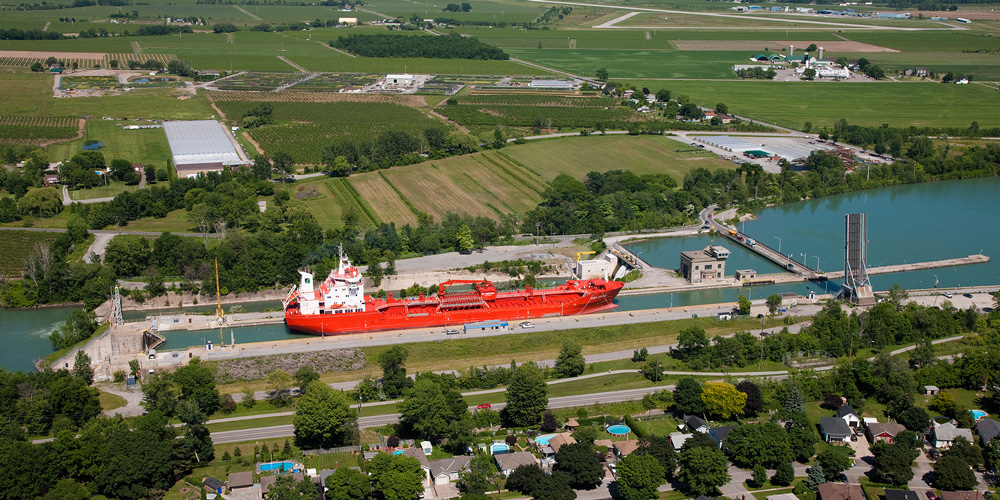Seaway Tonnage Set to Rebound
March 25, 2010
St. Catharines, Ontario (March 25, 2010) – The St. Lawrence Seaway began its 52nd navigation season on an upbeat note today, forecasting a 10% to 12% increase in tonnage volume for 2010. The tug / barge MarineLink Explorer owned by Upper Lakes Group Inc. was in the midst of transiting the Welland Canal’s Lock 3 as Richard Corfe, President and CEO of the St. Lawrence Seaway Management Corporation (SLSMC) declared the Seaway navigation season open.
Total Seaway cargo volume for 2009 amounted to 30.7 million tonnes, the lowest volume witnessed since the early 1960’s. The 25% decrease in cargo volume compared to 2008 is attributed to the depth of the recession, which sharply curtailed movements of iron ore and steel on the waterway. For 2010, the SLSMC is projecting a rebound in tonnage volume to 34 million tonnes.
“We do not harbour any illusions as to the challenges that await us” noted Mr. Corfe, speaking at the opening ceremonies which were held at the St. Catharines Museum adjacent to Lock 3. “While steel production is rebounding somewhat in 2010, we do not anticipate iron ore and steel product volumes will regain their historic highs at any point in the near future. This realization leads us to conclude that the Seaway must redouble its efforts to both retain its current users and diversify its client base.”
In a quest to retain current users and make Seaway transits more productive, the Seaway is testing vessel transits at a deeper draft within the existing channels. Utilizing advanced software, satellite navigation, and high resolution charts of the channel bottom, some vessels are being permitted to transit at a draft of 26’9” on a trial basis. By this means, vessels are able to carry more tonnage, further enhancing the marine mode’s class leading energy efficiency and low carbon footprint.
To effectively open up the Seaway to new uses and diversify its cargo base, the Seaway is continuing its development of Hands Free Mooring at Lock 7 of the Welland Canal. “Testing will continue this year, and the end result if successful will enable most of the world’s Seaway sized vessels to transit our locks without the use of mooring lines, eliminating the need for Seaway specific vessel modifications” outlined CEO Corfe.
Progress continues to be made on the ballast water management front. The findings of the 2009 report from the Great Lakes Seaway Ballast Water Working Group (a joint endeavour between Canadian and U.S. authorities) points out that 100% of all ballast water discharged into the Seaway / Great Lakes complied with the Seaway’s stringent requirements. Recent studies by leading academics reveal that no new invasive species attributable to ocean vessel transits have been reported since 2006.
Collister Johnson Jr., Administrator of the U.S. Saint Lawrence Seaway Development Corporation, spoke at the opening ceremony of the productive relationship that exists between the Canadian and U.S. Seaway entities. “All matters governing the Seaway as a whole must be coordinated and made jointly through a collaborative process, a fact which is sometimes forgotten by onlookers. I am proud of the long-standing culture of cooperation between the two Seaway Corporations.”
Recognizing that marine transportation plays an important but seldom understood role in Canada and the U.S., the Seaway Corporations are joining with major players within the marine trade to raise awareness with governments, media, and residents alike under the caption of “Marine Delivers”. The objective of Marine Delivers is to ensure that issues related to marine transportation are viewed within a full and balanced context. Marine transportation continues to be the most fuel efficient mode of transportation, having the lowest total greenhouse gas emissions per tonne-mile. Combined with the opportunity to lessen congestion on crowded land routes, moving more cargo via the marine mode on Highway H2O provides a range of green dividends.
As CEO Richard Corfe emphasized “the Seaway is not adverse to healthy debates. We simply want to ensure that all stakeholders are fully informed of all relevant facts before reaching a conclusion. Working together, government, industry and the Seaway can provide a means of continuing to build our economy and our quality of life while protecting the interests of generations to come, which is the true essence of sustainability.”
For more information on the St. Lawrence Seaway, please consult the www.greatlakes-seaway.com website.






